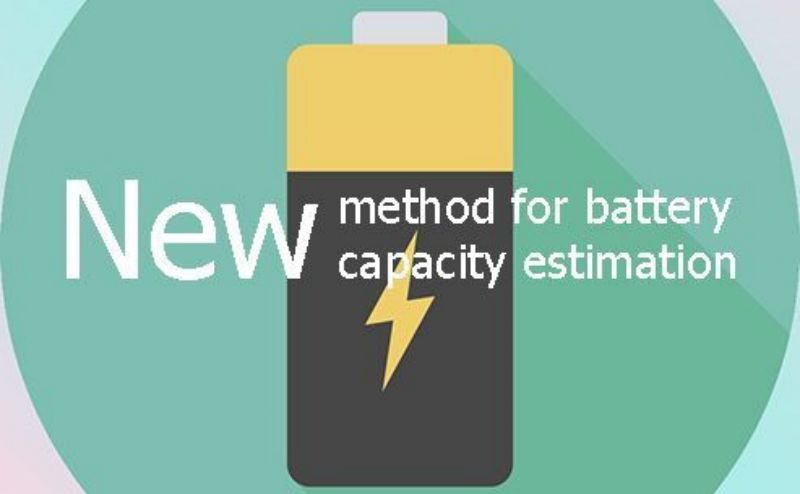
1. Research focus
The battery capacity is an important parameter in power battery management technology, and is a necessary input for ev vehicle level range and battery system level state estimation and life prediction. In this study, a new capacity estimation method based on the characteristic parameters of battery relaxation voltage is proposed by data-driven method. The method takes the current relaxation voltage information after full charge as the characteristic parameter and achieves the capacity estimation error (RMSE) of 1.1%. By constructing the transfer learning method to improve the generalization ability of the method, the method was verified on two other lithium-ion batteries with different material systems, and the estimated error was less than 1.7%. You will get to learn more detailed information about the new method for battery capacity estimation by reading this article.
The proposed capacity estimation method based on the characteristics of battery relaxation voltage has the advantages of being independent of battery history information and environmental information, and does not need specific battery test conditions and charging voltage range. The study released data sets for long cycle testing of commercial lithium-ion batteries in three different materials systems, including 130 cells in total, and each cell was cycled 50-1400 times according to different test conditions, including 3 temperature points (25oC, 35oC,45oC). 5 charge and discharge rates (0.25C,0.5C, 1C, 2C, 4C).
2. Background introduction
The development of power battery management has gone through three generations of management technologies, including threshold protection, state estimation drive and safety and life as the core, and has developed to the full life cycle and intelligent management. Information collection, state estimation and prediction, adaptive control and optimization management are common technologies in battery management.
Battery capacity is an important parameter in battery management technology. At the vehicle level, the maximum available capacity of the battery in the current state determines the sustainable driving range of an electric vehicle after charging. At the level of battery system, battery capacity is the necessary input of many key states in battery management technology, and also an important characterization of battery health and life. Therefore, it is very important to accurately obtain battery capacity information for vehicle application and management.
The most direct and accurate method to obtain battery capacity is the direct measurement method, which calculates the amount of charge transferred from the "full" state to the "empty" state. However, in practical application, the charging of power battery is completed by external charging pile, and the discharge is dynamically determined by the complexity of driver behavior and environment. The charging and discharging process of power battery is uncertain and incomplete, so the direct measurement method is not suitable for engineering application.
Voltage, as a key parameter of power supply system, has been shown to contain thermodynamic and kinetic information of battery. It is an important research direction to extract battery state information from battery voltage by machine learning method. The data-driven method does not require understanding the internal mechanism of the battery, but only needs to extract effective information from the macroscopic characteristic parameters, which has the advantage of simplified analysis. However, the method has strong data dependence and needs to obtain enough and perfect data. Feature engineering is the key step of data - driven approach. Compared with the discharge process, the charging process of vehicle battery is more stable. Currently, the characteristic parameters are usually extracted during the charging process of the battery.
This article lists the current capacity estimation methods of battery charging curve in detail. According to the voltage curve segment used, it can be divided into (1) constant current method; (2) constant current and constant voltage method and (3) relaxation voltage method. Among them, constant current method and constant current and constant voltage method have been studied more, and a variety of machine learning algorithms (support vector machine, correlation vector machine, random forest regression, Gaussian process regression and neural network, etc.) have been used to build the relationship between characteristic parameters and battery capacity. With the rapid development of vehicle charging technology, especially for the demand of fast charging, the application of constant current method (constant current and constant voltage method) has certain application limitations, such as the adoption of charging strategies such as high rate and step changing current.
The relaxation voltage method uses the battery standing voltage after cutting off the current as the characteristic parameter, which is not limited to the influence of battery charging strategy, and the statistical results show that the occurrence probability of vehicle-mounted battery reaching the fully charged state is relatively high. It has been shown that the relaxation process of batteries can reflect the decay mechanism of batteries. However, due to the limited information of relaxation voltage contained in the current public battery data set, there are few researches on battery capacity estimation using relaxation voltage method.
Based on the above analysis, this text first constructed the cycle test data set of three lithium-ion batteries with different material systems as shown in the table below. The data set contained 130 cells, and the experimental conditions included 3 temperature points (25oC,35 oC,45 oC) and 5 charge and discharge rates (0.25C,0.5C, 1C, 2C, 4C). Based on the constructed battery data set, a battery capacity estimation method based on relaxation voltage characteristic parameters is developed.
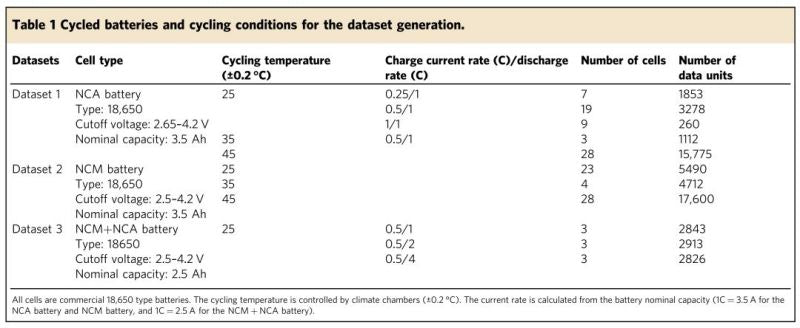
3.Graphical guide
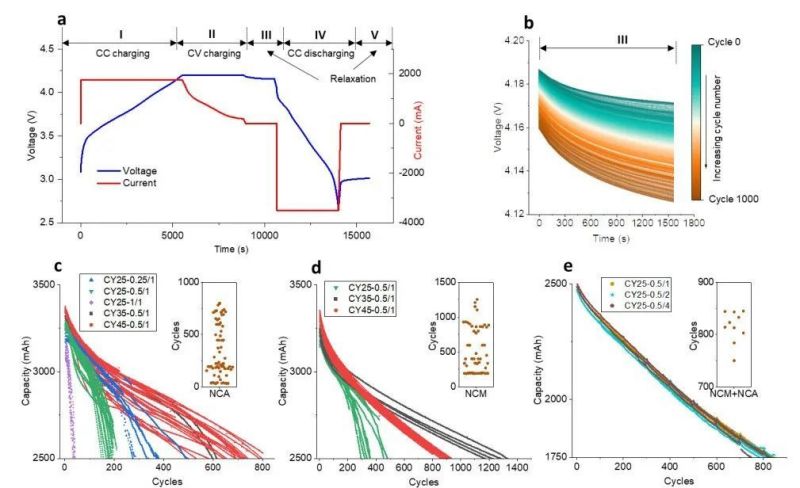
Figure 1. Battery cycling data
Through battery cycling tests, this paper constructs cycling datasets of three commercial lithium-ion batteries, which are named NCA batteries, NCM batteries, and NCM+NCA batteries according to their cathode materials. As shown in Figure 1, the current-voltage curve of the first cycle of a certain NCA battery (1a); the variation of the relaxation voltage during the cycle of a certain NCA battery (1b), the characteristic parameters in this paper are extracted from stage III; three models The capacity fading of the battery corresponds to (1c), (1d) and (1e); respectively. The meaning of the legend CYX-Y/Z: X is the battery cycle temperature, and X/Y corresponds to the charge/discharge current. The modeling data constructed by NCA battery data is studied, and ElasticNet, XGBoost and SupportVector Regression (SVR) are used as the base model (BaseModel). NCM battery and NCM+NCA battery data were used for method validation data with transfer learning model.
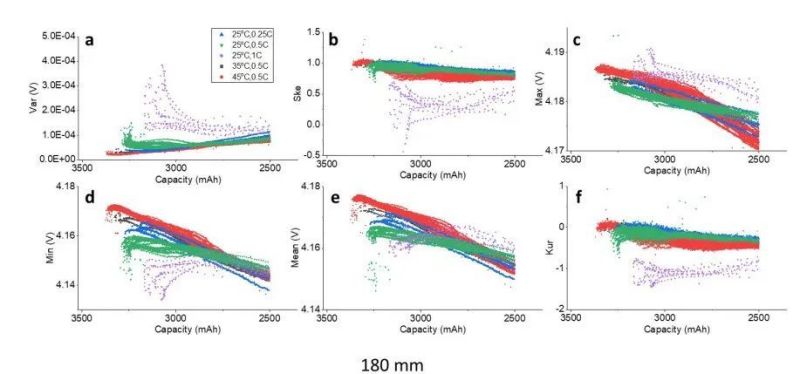
Figure 2. Relationship between characteristic parameters of relaxation voltage and capacity of NCA battery
Using mathematical statistics, each relaxation voltage curve of NCA battery is quantified into variance (Var), skewness (Ske), maximum value (Max), minimum value (Min), mean value (Mean) and excess peak Degree (Kur) six characteristic parameters. The relationship between the six characteristic parameters of the relaxation voltage and the battery capacity under the five cycle test conditions of the NCA battery is shown in Fig. 2. The research adopts the method of stratified sampling, that is, under each test condition, the batteries are quantitatively divided into training set and test set according to the ratio of about 4:1. The XGBoost algorithm is used to operate on any combination of the above six feature parameters, and the optimal feature parameter combination of (i,j) = (7, 1) = [Var, Ske, Max] is determined according to the results of the cross-validation operation, as shown in the figure 3.
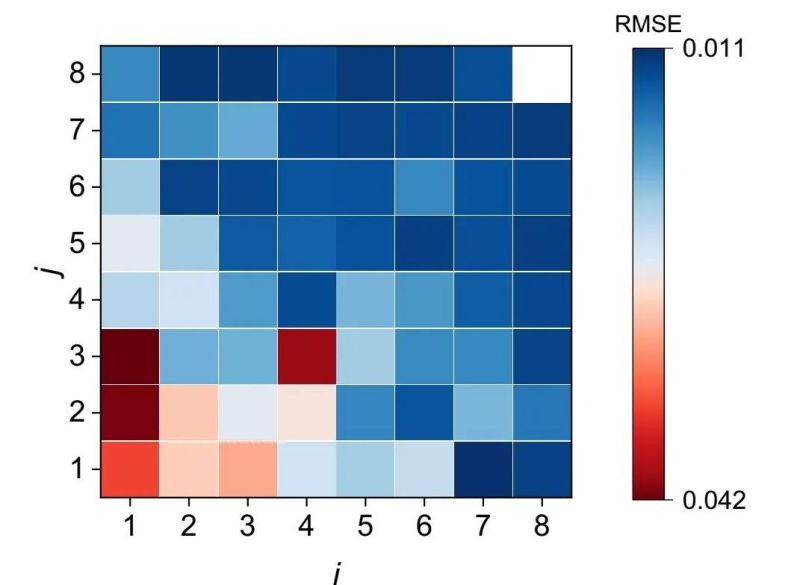
Figure 3. Heatmap of estimation accuracy under different feature parameter combinations
Using the combination of [Var, Ske, Max] feature parameters to perform operation analysis on different machine learning algorithms, the results are shown in Figure 4a. The proposed method for capacity estimation based on the characteristic parameters of relaxation voltage has low accuracy on ElasticNet, and has similar effects on XGBoost and SVR, and the test error (RMSE) is both 1.1%. See 4b, 4c, and 4d for a comparison of the corresponding true and estimated capacities.
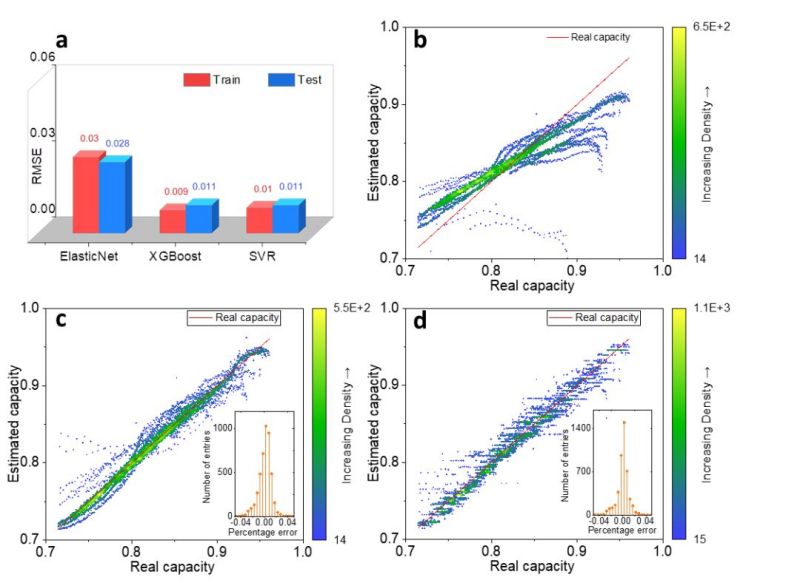
Figure 4. Accuracy comparison of NCA battery capacity estimation results on three basic models
This dataset provides the constant current (constant current and constant voltage) charging voltage data of the battery. Therefore, this paper applies the constant current method and constant current and constant voltage method proposed in some literatures to this dataset, and the comparison results are shown in Table 2.
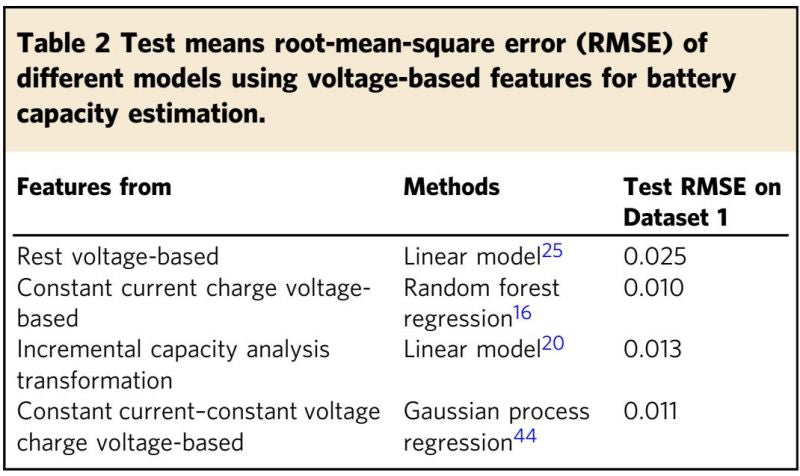
In this study, the attenuation mechanism of three commercial batteries was investigated using AC impedance. The change in impedance during battery decay was quantified as ohmic internal resistance (R0), SEI internal resistance (R1), and electrochemical migration internal resistance (R2) using an equivalent circuit model, and the results are shown in Figure 5. The complex differential variation of battery internal resistance with test conditions demonstrates the limitations of using only linear models for battery decay studies. The internal resistance changes of different types of batteries also show a certain similarity. For example, R2 shows an exponential upward trend, which provides the possibility for the application of the transfer learning method in the following.
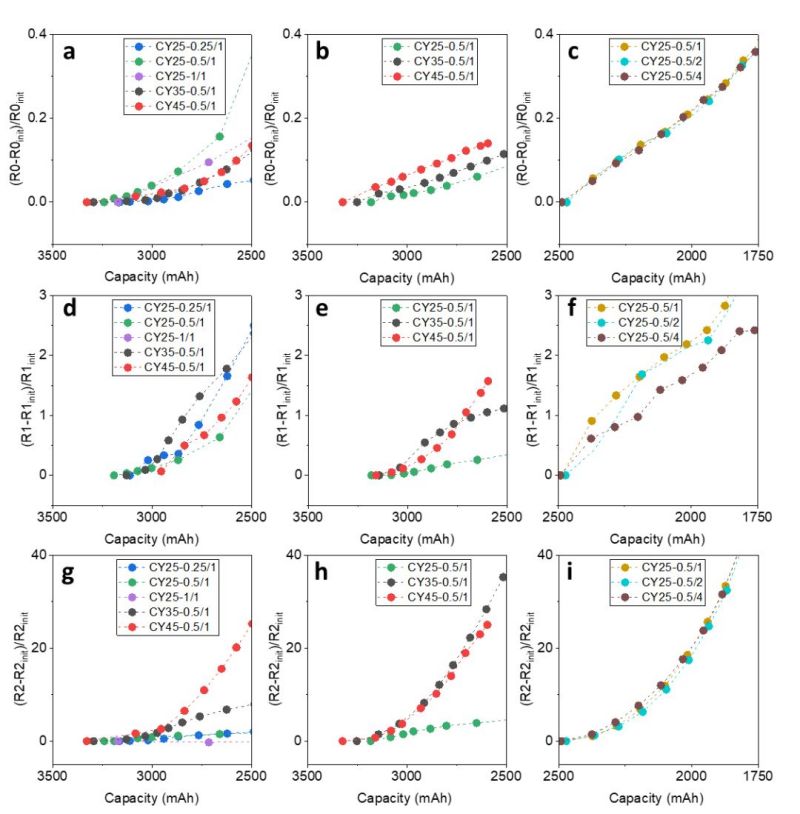
Figure 5. Impedance changes during the decay process of three lithium-ion batteries
In order to improve the generalization and universality of the established battery capacity estimation method based on the relaxation voltage characteristic parameters, this paper builds a transfer learning model based on the basic models of the XGBoost and SVR algorithms, and uses it in NCM batteries and NCM+NCA. The method is verified on the battery data set, and the verification results are shown in Table 3.
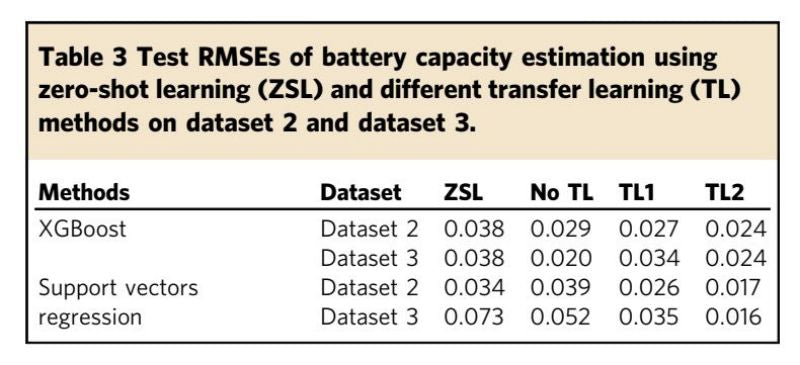
Two transfer learning models are designed: TL1 is to add a linear transformation layer of capacity at the back end of the basic model; TL2 is to add a linear transformation layer of feature parameters to the front of the basic model. ZSL is zero-shot learning (Zero-ShotLearning), and NoTL is to directly use the new dataset to retrain the full model. The training data for the transfer learning model accounts for 0.06% and 0.35% of the datasets for NCM batteries and NCM+NCA batteries, respectively. It can be seen that using the SVR-based TL2 algorithm achieves 1.7% validation results on two new datasets. The corresponding real and estimated capacity comparisons are shown in Figure 6.
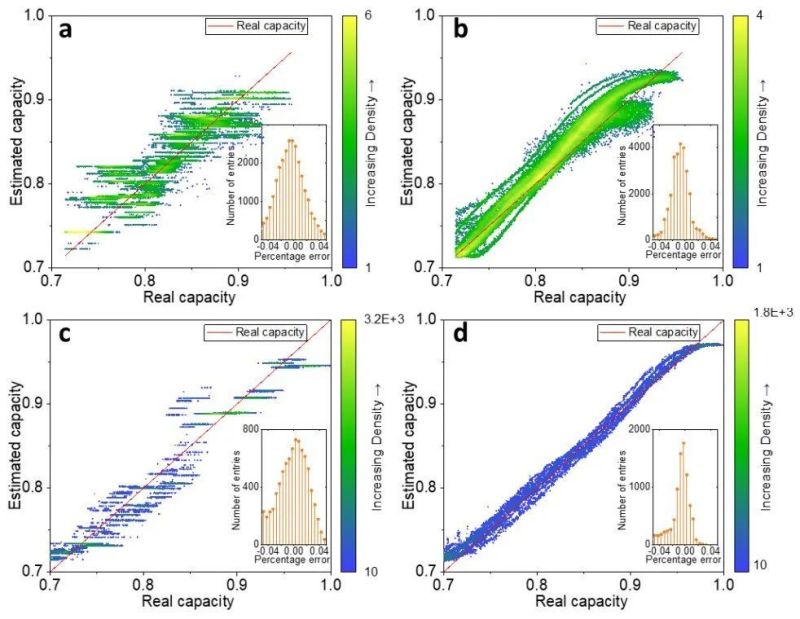
Figure 6. Validation results of transfer learning method TL2 on NCM battery and NCM+NCA battery
4. Summary
In this study, with the help of data-driven method, the proposed method for battery capacity estimation based on relaxation voltage characteristic parameters is independent of battery historical information and environmental information, and has the advantage of not requiring specific battery test conditions and charging voltage range. Transfer learning method is constructed to improve the generalization and universality of capacity estimation method.
In this research, the battery cycle test data and related data processing algorithms of 130 lithium-ion batteries are open-sourced for reference by relevant practitioners. The research provides new research ideas and solutions for various application scenarios and power technology development of vehicle power batteries, such as parking charging, battery replacement, echelon service life evaluation and life prediction.